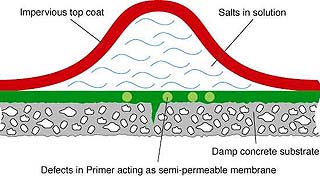Osmotic Blistering
Synopsis:
Osmotic blistering can be one of the biggest concerns for coating installers. However, regardless of its disastrous effects, there are preventive measures that experienced coating applicants can apply.
Breakdown of Osmotic Blistering, and preventive solutions:
- What is osmotic blistering?
- How does osmotic blistering damage floor system applications?
- How do coating specialists prevent this floor system disaster?
Osmotic blistering is an invisible enemy for almost all coating applications. It is damaging and costly. When searching for a coating application installer, it is important to find one that has the experience and resources to combat this hazard. PennCoat, Inc. has over 25 years of application experience, and can help determine if your floors are susceptible to these invisible enemies. And if they are susceptible, PennCoat, Inc. will provide viable solutions to prevent blistering or bubbling in a floor system application.

What is Osmotic Blistering?
Osmotic blistering is “the phenomenon in physical chemistry, by which solutions try to reach equilibrium across a semi-permeable membrane.” Basically, water will flow from one solution to another, trying to create equilibrium between both solutions. And most of the time, the two solutions are concrete and the coating application on top of the concrete. Concrete is very porous, so water beneath the concrete, will force itself through the concrete, typically through vapor transmission. The water will then break through the “semi-permeable membrane” (either the surface of the concrete or the primer). But most epoxies or urethanes or polymer applications aren’t permeable. So as the water will stop at the polymer coating. But the pressure from the water doesn’t stop, forcing the water to collect directly in between the concrete and layer of epoxy/urethane. This collection creates the notorious “osmotic blister” that is commonly feared by coating specialists.
The Damage that is Done
Once osmotic blistering occurs, there is no return. Thousands of dollars can be lost if an inexperienced floor system installer doesn’t address a potential problem. Facilities have been forced to remove thousands of square feet of application, after finding out a few days later that their floors are covered in speckled blisters. So it is imperative that the maintenance or facility manager identifies a qualified, experienced, and knowledgeable coat(ing) application specialist.
One of the first factors floor installers should notice is the amount of moisture relative to the area. Is your facility below sea level? Are there rivers, creeks, or lakes in the area? This would suggest a lot of underground water. Does the area receive a lot of rain or snow? When it does rain or snow, where does the water drain? These are some general questions that can let you know how likely it that osmotic blistering may be a problem that will require a solution. Cement, by itself, already contains as much as 5% free water by weight, which is enough to cause osmotic blistering. And once you factor in the outside sources to the equation, the likeliness only increases.
PennCoat, Inc. has the experience and solutions for this industry-wide problem
As mentioned, qualified coating specialists will not only be able to identify high-risk areas, but they’ll be able to provide viable solutions.
Vapor Barrier
A vapor barrier is the best way to help prevent osmotic blistering. A vapor barrier is a plastic layer installed beneath the concrete. This plastic layer will prevent water from migrating through the concrete, thus preventing water from collecting beneath the polymer application. However, the obvious set back with this solution is that it has to occur before the concrete is poured. Most facilities that require solutions, already have their concrete floors poured and cured, requiring an alternative solution.
Tests
There are ways to test the area for vapor transmission. The simplest method is a calcium chloride test. Over a 3 day period, this test will measure the moisture passing through the concrete. If your concrete floors are transmitting less than 3 pounds per 1000 square feet, then they are at the lowest risk of osmotic blistering. However, more than 3 pounds will require a special application called a moisture mitigation system.
Moisture Mitigation System application
If PennCoat, Inc. or any other qualified coating specialist finds that your facility is at high risk of osmotic blistering, then a moisture mitigation system will be recommended. A moisture mitigation system is a formulated epoxy that can bond to concrete with humidity as high as 99%. Once applied, the moisture mitigation system can reduce vapor emission levels as high as 20 lbs/1000 square foot to 3 lbs/1000 square foot. By reducing the vapor emissions, you’re reducing the likeliness of osmotic blistering in your plant or facility.
In conclusion, osmotic blistering can be one of the most damaging threats to any floor system. It is important to hire qualified application professionals, like PennCoat, Inc. so that any potential osmotic hazards can be recognized, and dealt with accordingly. Hiring the coating specialist will save you thousands in the long run.
If you’re looking for coupons or coupon codes, consider one of these great coupon providers for industrial projects.
